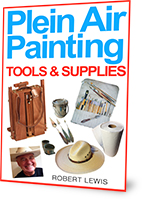So much to think about when you are about to begin a plein air painting! To keep from being overwhelmed from the start and to insure success, take a Mandatory Deep Breath and then ask yourself these five questions:
- What is the subject I am about to paint?
Something caught your eye about the scene before you. What was that thing? This thing is the focus, the actual subject of the composition or, more to the point, it is the actual focus within the composition. Remember to keep attention here. Everything else in the painting should support this subject and bring the eye to it. Throughout the painting process, continue to focus on the focus. - What am I not going to paint?
In the scene, are there any confusing objects or areas which are hard to understand? This could be an oddly shaped boulder in a scene that, otherwise, has no boulders. Or, one object is overlapping another object in such a way as to confuse the eye. Any trouble spots like this are likely candidates for deletion. Leave them out if they are not important to the overall composition or, more importantly, if the eye will keep going to this object with the question “what is that?”. - Do I have my brushes, my palette knives, my medium?
While this may seem laughable, it won’t be so funny if you reach for your brushes and find you’ve forgotten them. This happens. To prevent this in the first place, use the checklist here. If you have forgotten brushes, use a palette knife. If you’ve forgotten palette knives, use a credit card. No medium? Borrow some. None to borrow? Go home. - Do I have all of my colors with me?
Some colors are simply essential. White, for example. However, as long as you have white and some version of primary colors, all is not lost. Let’s say you only have white, a red, a yellow, and black. No problem, you have a basic Zorn palette. Anders Zorn painted much of his work with this limited palette. See the Zorn palette mixed in this video. - Is this subject worth spending a few hours of my life on?
Seriously, this is where it is worth taking a moment to ponder the questions “If I successfully paint this composition, will I have a painting that supports my overall direction? Will it be a good addition to my body of work? Or is it a departure that makes no sense in my portfolio?” At this point, before you begin, you can decide whether to proceed or find a better subject.
All content on this site is © 2015 Robert Lewis. All Rights Reserved. This intellectual property is strictly protected. Do not use without written permission from the copyright owner.






